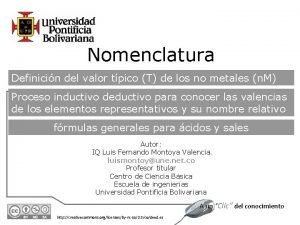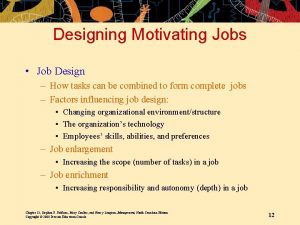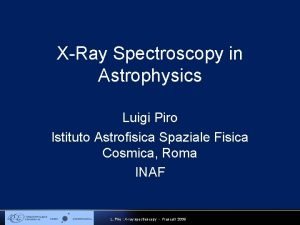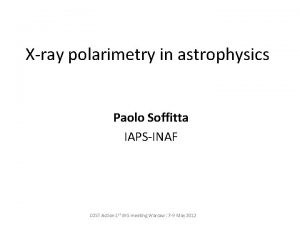Luigi Piro IAPSINAF The Science Theme motivating the

















- Slides: 17

Luigi Piro (IAPS/INAF)

The Science Theme motivating the Athena mission

Key questions for observational astrophysics in 2028 1. How does ordinary matter assemble into the large scale structures we see today? Extended X-ray sources Oppenheimer et al. 2009 Athena Deep Field Pointecouteau, Reiprich et al. , 2013 ar. Xiv 1306. 2319

The formation and evolution of clusters and groups of galaxies How and when was the energy contained in the hot intra-cluster medium generated? z=2 z=1 Pointecouteau, Reiprich et al. , 2013 ar. Xiv 1306. 2319 1000 Entropy profile Pure gravitation With. AGNand supernovaheating 100 Athena Simulation 10 100 Radius (kpc) How does ordinary matter assemble into the large-scale structures that we see today? 1000

The chemical evolution of hot baryons When and how were the largest baryon reservoirs in galaxy clusters chemically enriched? z=2 cluster Ettori, Pratt, et al. , 2013 ar. Xiv 1306. 2322 How does ordinary matter assemble into the large-scale structures that we see today?

The Warm-Hot intergalactic medium (WHIM) Where are the missing baryons in the local Universe? What is the underlying mechanism determining the distribution of the hot phase of the cosmic web? Kaastra, Finoguenov et al. , 2013 ar. Xiv 1306. 2324 How does ordinary matter assemble into the large-scale structures that we see today?

Key questions for observational astrophysics in 2028 1. How does ordinary matter assemble into the large scale structures we see today? 2. How do black holes grow and shape the Universe? Extended X-ray sources X-ray point sources Athena Deep Field

Cosmic feedback: the origin of black hole winds How do black holes launch winds and outflows? How much energy do they carry out to larger scales? Cappi, Done et al. , 2013 ar. Xiv 1306. 2330 Dovciak, Matt et al. , 2013 ar. Xiv 1306. 2331 How do black holes grow and shape the Universe?

Black hole growth in the early Universe What was the growth history of black holes in the epoch of reionization? Aird, Comastri et al. 2013 ar. Xiv 1306. 2325 How do black holes grow and shape the Universe?

The first stars, the first BH, the first metals z=1089 Pop III collapsars ? z=5 Pop II z=12 GRBs Dark Ages Reionization GRB Quasar Galaxy z=0


The first stars and black holes When did the first generation of stars explode to form the first seed black holes and disseminate the first metals in the Universe? Gamma Ray Burst at z=7 Jonker, O'Brien et al. , 2013 ar. Xiv 1306. 2336 How do black holes grow and shape the Universe?

The Athena Observatory Willingale et al, 2013 ar. Xiv 1308. 6785 L 2 orbit Ariane V Mass < 5100 kg Power 2500 W 5 year mission Silicon Pore Optics: 2 m 2 at 1 ke. V 5 arcsec HEW Focal length: 12 m Sensitivity: 3 10 -17 erg cm-2 s-1 X-ray Integral Field Unit: DE: 2. 5 e. V Field of View: 5 arcmin Operating temp: 50 mk Barret et al. , 2013 ar. Xiv: 1308. 6784 Wide Field Imager: DE: 125 e. V Field of View: 40 arcmin High countrate capability Rau et al. 2013 ar. Xiv 1307. 1709

The first Deep Universe X-ray Observatory Athena has vastly improved capabilities compared to current or planned facilities, and will impact on virtually all areas of astrophysics Line Sensitivity 100 x ASTRO-H Survey 1000 x Speed XMM-Newton X-ray spectroscopy at the peak of the activity of the Universe Deep survey capability into the dark ages and epoch of reionization

Athena science in context Athena is a crucial part of the suite of large observatories needed to reach the science objectives of astronomy in the coming decades

Athena milestones • Oct 2013: Senior Survey Committee and SPC recommend “The Hot and Energetic Universe” them for L 2 mission in 2028 • Jan 2014: Call for mission proposals • Apr. 2014: Athena proposal • 2015: Phase A started • 2015 -2018: Technology development phase • 2019 -20: Start implementation phase • 2028 LAUNCH!

Study Team & Community Organization http: //www. cosmos. esa. int/web/athena
 Sales ácidas
Sales ácidas Meta piro orto
Meta piro orto Coral piro
Coral piro Benoit piro
Benoit piro Why is science my favourite subject
Why is science my favourite subject Motivating parallelism
Motivating parallelism How to motivate esl students
How to motivate esl students Herzberg’s two-factor theory
Herzberg’s two-factor theory Designing motivating jobs
Designing motivating jobs Cmo-t examples
Cmo-t examples Generalized conditioned reinforcement
Generalized conditioned reinforcement Motivating and satisfying employees and teams
Motivating and satisfying employees and teams Motivating operations definition
Motivating operations definition Motivating sales force
Motivating sales force Exploitative authoritative example
Exploitative authoritative example Channel motivation meaning
Channel motivation meaning Staffing and directing
Staffing and directing Motivating developers
Motivating developers

































